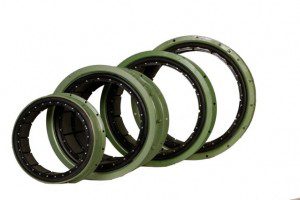 Grab. Spin. Decouple. Repeat.
Grab. Spin. Decouple. Repeat.
At one level, clutches really are that simple. But pneumatic clutches are just one example of what a few innovative twists can do to complicate (and improve) the process.
So let’s start with the basics:
All clutches””whether K&L’s mechanical clutches, air clutches, or hydraulic clutches””work essentially the same way, and provide the same larger function.
They work to synchronize two rotating shafts (say a car’s transmission and engine) that are spinning at different speeds.
The clutch can connect the two shafts, locking them together to spin simultaneously or decouple the shafts to spin again at different speeds (when you’d want to stop a car without turning off the engine).
All sorts of technical variations exist. But engaging a clutch (releasing the clutch pedal in a car, for example) almost always moves power from an engine to another part of the machine (like a car’s transmission).
Disengaging usually stops that power transfer without stopping the engine (thus avoiding an engine stall).
To get more specific, when the clutch is engaged in a vehicle, its clutch plate usually makes direct contact with something like a car’s flywheel.
To disengage, something like a release fork is pushed by a cable or a hydraulic piston. This pushes a throw-out bearing against the middle of the diaphragm spring, which pulls the press plate back away from the clutch disc. The clutch is then released.
Clutches allow cars to change gears, chainsaws to idle, drills to spin bits, and large machines to run at optimum power.
Pneumatic Clutches
The basic feature, of course, of all pneumatic machines is that such devices are powered by clean, compressed air. Pneumatic clutches are no different.
Most smaller vehicles use mechanical clutches, but pneumatic clutches offer some amazing advantages for many machines and situations.
Where mechanical clutch does everything with moving, tangible parts, pneumatic brake clutches transfer power from one part of a machine to another using compressed air or other gases.
Pneumatics is the branch of technology that concerns the way gases can be used for mechanical purposes. In most pneumatic machinery, the gas used is the simplest of gases “” clean air.
In other words, pneumatics usually describes the use of air to move things. Unlike mechanical clutches (where solid moving parts do all the work), pneumatic clutches employ tightly compressed air to transfer energy from one moving part of a machine to another.
For example “” you know those air tubes at the bank drive-through?
Those use pneumatics in a similar, albeit much simpler, way. At the bank drive-through, when you put a check into the container and send it off, the compressed air quickly shoots through the tube and pushes the container all the way to the bank teller.
Upon clutch disengagement, an air valve is opened and an air flow is initiated through a rotary inlet through the shaft, toward the pneumatic throw-out bearing, which opens the clutch.
Re-engagement bleeds the air out of the system, a set of springs release, and the clutch reattaches to the flywheel. Then you’re ready to go.
Results
Compressed air is usually clean and easy to handle. In fact, the simplicity of pneumatic clutches leads to much more accurate torque control (with generally less than 5 percent variance) compared to mechanical clutches (often around ten percent).
When combined with pneumatic brakes, the brake/clutch packages provide reduced braking distances and are often used in larger, heavier vehicles like buses.
If you are looking for pneumatic clutches for your heavy machinery and equipment or for clutch repairs, contact K&L Clutch today!


























It was interesting to see the literature.
I wanted to have pneumatic clutch operating circuit and get rid of heavy clutching force on the pedal.
My brother recommended I may like this blog. He was entirely right. This post actually made my day. You cann’t believe simply how much time I had spent for this info! Thank you!